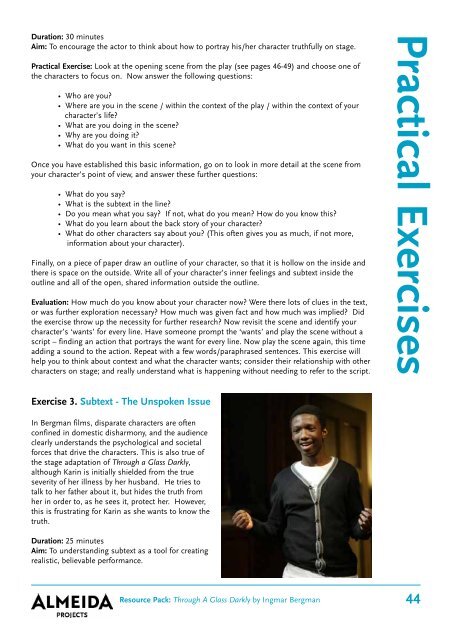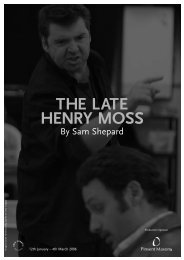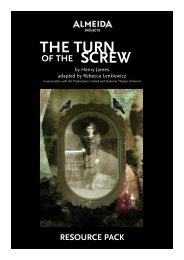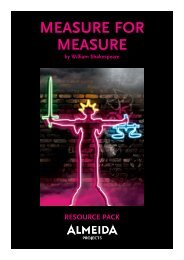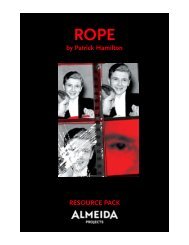Through a Glass Darkly - Almeida Theatre
Through a Glass Darkly - Almeida Theatre
Through a Glass Darkly - Almeida Theatre
- No tags were found...
Create successful ePaper yourself
Turn your PDF publications into a flip-book with our unique Google optimized e-Paper software.
Duration: 30 minutesAim: To encourage the actor to think about how to portray his/her character truthfully on stage.Practical Exercise: Look at the opening scene from the play (see pages 46-49) and choose one ofthe characters to focus on. Now answer the following questions:• Who are you?• Where are you in the scene / within the context of the play / within the context of yourcharacter’s life?• What are you doing in the scene?• Why are you doing it?• What do you want in this scene?Once you have established this basic information, go on to look in more detail at the scene fromyour character’s point of view, and answer these further questions:• What do you say?• What is the subtext in the line?• Do you mean what you say? If not, what do you mean? How do you know this?• What do you learn about the back story of your character?• What do other characters say about you? (This often gives you as much, if not more,information about your character).Finally, on a piece of paper draw an outline of your character, so that it is hollow on the inside andthere is space on the outside. Write all of your character’s inner feelings and subtext inside theoutline and all of the open, shared information outside the outline.Evaluation: How much do you know about your character now? Were there lots of clues in the text,or was further exploration necessary? How much was given fact and how much was implied? Didthe exercise throw up the necessity for further research? Now revisit the scene and identify yourcharacter’s ‘wants’ for every line. Have someone prompt the ‘wants’ and play the scene without ascript – finding an action that portrays the want for every line. Now play the scene again, this timeadding a sound to the action. Repeat with a few words/paraphrased sentences. This exercise willhelp you to think about context and what the character wants; consider their relationship with othercharacters on stage; and really understand what is happening without needing to refer to the script.Practical ExercisesExercise 3. Subtext - The Unspoken IssueIn Bergman films, disparate characters are oftenconfined in domestic disharmony, and the audienceclearly understands the psychological and societalforces that drive the characters. This is also true ofthe stage adaptation of <strong>Through</strong> a <strong>Glass</strong> <strong>Darkly</strong>,although Karin is initially shielded from the trueseverity of her illness by her husband. He tries totalk to her father about it, but hides the truth fromher in order to, as he sees it, protect her. However,this is frustrating for Karin as she wants to know thetruth.Duration: 25 minutesAim: To understanding subtext as a tool for creatingrealistic, believable performance.Resource Pack: <strong>Through</strong> A <strong>Glass</strong> <strong>Darkly</strong> by Ingmar Bergman 44


